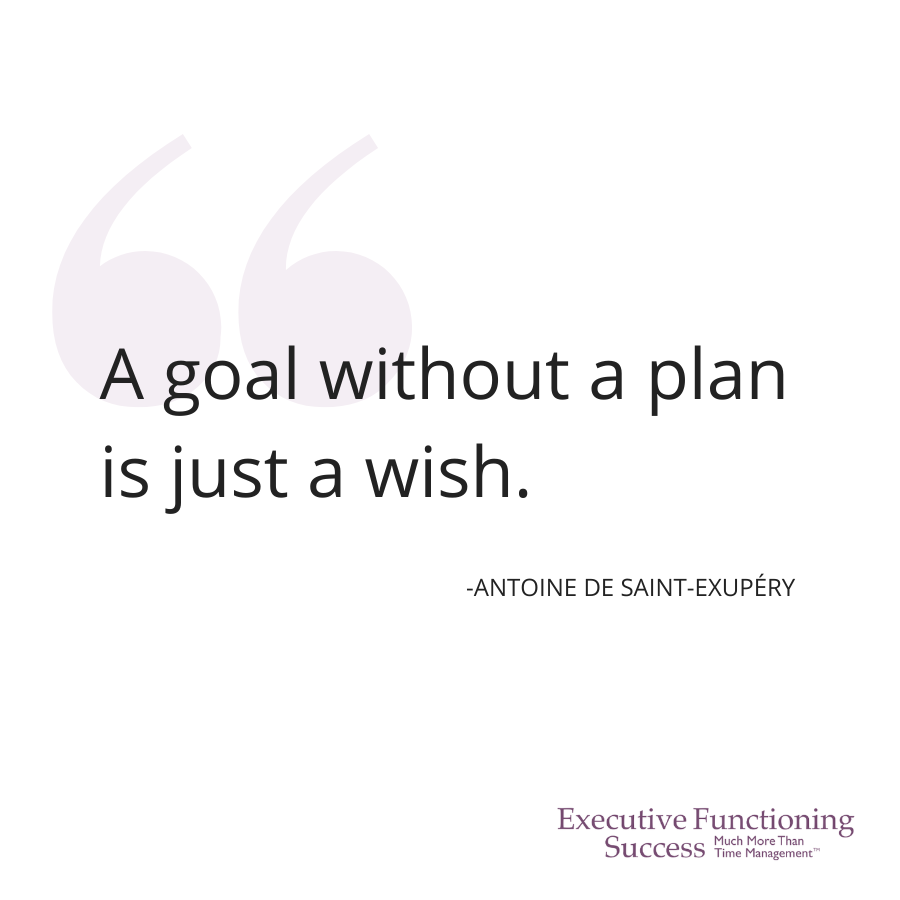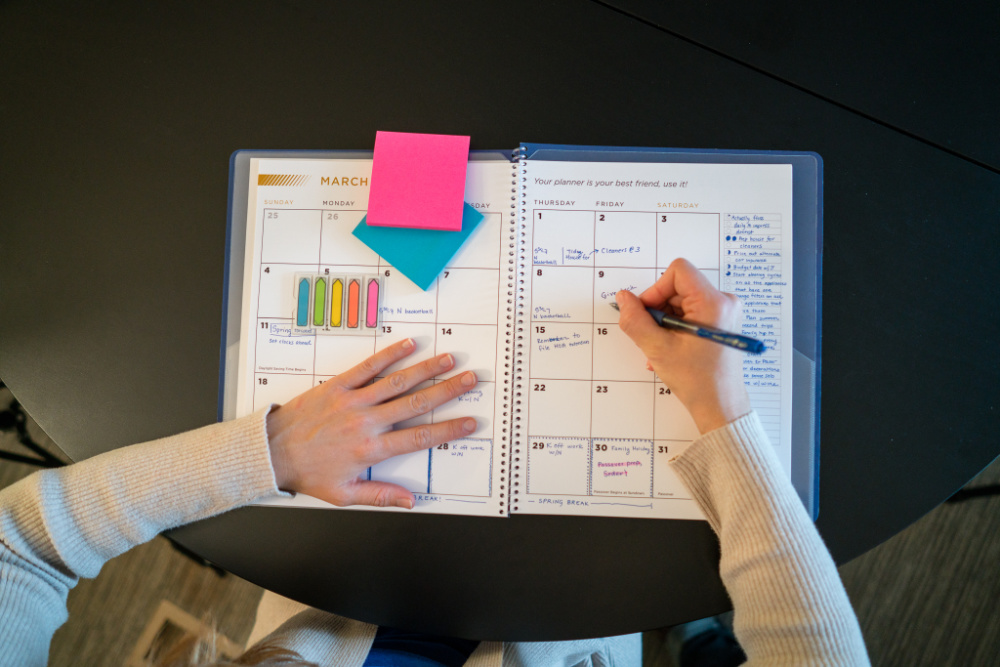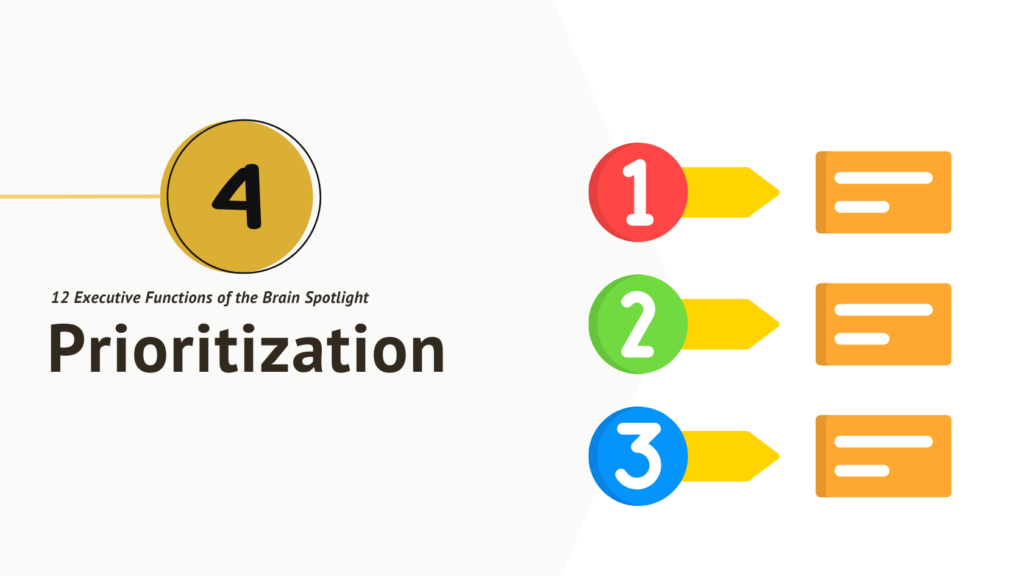In January, many of you sat down and wrote personal goals for 2024, which is the first activity in your Seeing My Time® planner system.
Identifying your goals and evaluating their achievability is the first step to activate the executive function of planning, i.e. thinking into the future. Last month’s blog discussed some ways to think about goal setting so that you set up success rather than failure.
Creating a list of goals is often the easiest step of planning. ACHIEVING your goals is a whole different thing. This is where many folks get stuck.
The key is to break a big goal into smaller doable tasks. Then make a plan to do those steps using the Seeing My Time Planner. If you don’t have a Seeing My Time Planner, you can still use many of these tips with a regular planner. Let’s get into it!
Steps for Prioritizing Goals
“A goal without a plan is just a wish,” is a wonderful quote from the French author Antoine de Saint-Exupéry. I share this quote when I teach people my Seeing My Time® program. After my clients put down a goal to work on, we then analyze why it is hard to make progress. We talk about how the root of procrastination is not having a clear picture of exactly what you need to do. Here are ten simple steps you can use to get that clear picture.
1. Pick One Goal
To begin, hone in on a SINGLE goal – preferably one that doesn’t have too many steps. You want to achieve success in a short space of time, to prove to your brain that you CAN achieve a goal. Write the goal down in your planner goal pages or on a whiteboard.

2. Break the Goal into Steps
Underneath your goal heading, create a bullet list of the action steps you need to take. Make these steps small or even tiny. You want to set up a feeling of success in your brain because that dopamine hit for accomplishment will help sustain your motivation.
3. Estimate Time for Each Step
Consider the amount of time required for each step. Write it down next to that step. If it is more than an hour, break it into a smaller space of time to get past resistance. In this case, you could break it into 10, 15 or 30-minute chunks. Your goal is not to complete the step but to make PROGRESS. I use something I call time circles to represent the time needed.
4. Create Movable Sticky Flags for Each Step
Write each step on a sticky flag, including a time circle. The flags will be used to keep the goal’s steps in front of you and help you figure out when to do that step. I like the neon ones, so you can easily see your writing against the color of the flag. These are linked in our Cool Tools page.
5. Use your Monthly Calendar Pages
Start with the deadline for your goal. When does it need to be completed? Open your monthly calendar to the deadline date and write on the correct date: “Goal: DONE!” If there isn’t a hard deadline for this goal, write it in pencil.
6. Plan When You Anticipate Working on Each Step
Using your monthly calendar, plan backward from completion to your present week. Place each of your sticky flags on the dates you would like to work on that step.

7. Stay Flexible
Breathe. At this point, you may have little idea as to the particulars for those dates in the future. Don’t worry about it. These flags are moveable for a reason. They are simply acting as a visual reminder of your commitment to work on your goal somewhere around that time in the future.
8. Weekly Monitoring
Check your monthly calendar each week to see which step of your goal needs to be a priority for the coming seven days.
9. Move Your Sticky Flag from the Month Calendar to Your Week Plan
Look at the week ahead to determine when you have an open space where you can work on this week’s goal step. Place your flag in that space of time, reserving that space of time for that step. Don’t let anyone take over that time! If you share your calendar with others, block that time with words: Project progress time. Label the project if it is a work calendar so others know why to respect that time.

10. Put the Step on Your Day Plan and Make Progress
Move your flag to the space of time you have saved for this step. Honor the importance this goal has in your life. Remember you may not be able to finish this step on this day. That is ok. You just have to make progress. Little by little is the key to reaching goals, no matter their size or complexity.
Following these steps to accomplish goals will lead to all manner of wonderful things getting done in your life, professionally and personally. Be brave. Pick a doable goal. Get your planner and some sticky flags. Keep the goals tiny so you can easily celebrate successes along the way. You can do this. I’ve done all manner of hard, scary and complicated things in my life using these strategies. You can too!
Little by little,


